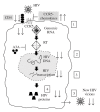Macrophage polarization in health and disease
- PMID: 22194670
- PMCID: PMC3236674
- DOI: 10.1100/2011/213962
Macrophage polarization in health and disease
Abstract
Macrophages are terminally differentiated cells of the mononuclear phagocyte system that also encompasses dendritic cells, circulating blood monocytes, and committed myeloid progenitor cells in the bone marrow. Both macrophages and their monocytic precursors can change their functional state in response to microenvironmental cues exhibiting a marked heterogeneity. However, there are still uncertainties regarding distinct expression patterns of surface markers that clearly define macrophage subsets, particularly in the case of human macrophages. In addition to their tissue distribution, macrophages can be functionally polarized into M1 (proinflammatory) and M2 (alternatively activated) as well as regulatory cells in response to both exogenous infections and solid tumors as well as by systems biology approaches.
Keywords: HIV; M1/M2; TAMs (tumor-associated macrophages); macrophage; polarization; regulatory macrophages; tumors.
Figures

References
-
- Gordon S, Taylor PR. Monocyte and macrophage heterogeneity. Nature Reviews Immunology. 2005;5(12):953–964. - PubMed
-
- Gordon S. The macrophage: past, present and future. European Journal of Immunology. 2007;37(1):S9–S17. - PubMed
-
- Gordon S. Alternative activation of macrophages. Nature Reviews Immunology. 2003;3(1):23–35. - PubMed
Publication types
MeSH terms
Substances
LinkOut - more resources
Full Text Sources
Other Literature Sources

